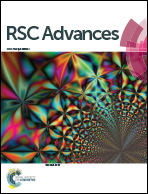Direct preparation of PNIPAM coating gold nanoparticles by catechol redox and surface adhesion chemistry†
Abstract
This paper describes a straightforward single-step method for the preparation and decoration of gold nanoparticles with a poly(N-isopropylacrylamide) (PNIPAM) shell in a water solution. This methodology is based on catechol redox and adhesion properties. PNIPAM containing a catechol end group is used in water as both a reducing agent of HAuCl4 and a capping agent of the resulting gold nanoparticles. Polyhedral gold nanoparticles are obtained at pH = 11.6. However, branched gold nanoparticles are obtained at a neutral pH. This strategy for generating gold nanoparticles coated with a PNIPAM shell, especially branched gold nanoparticles, is a surfactant-free method, in particular cetyltrimethylammonium bromide, which is widely employed in the generation of branched gold nanoparticles and many toxicity concerns have been raised about its use. Nowadays, one of the topics on which gold nanoparticle research is focused, is the use of branched gold nanoparticles and their modification with a polymer shell to be employed in surface enhanced Raman scattering (SERS) detection. The branched gold nanoparticles coated with a PNIPAM shell described here present a high colloid stability in water and are used in the direct SERS detection of pyrene in water solution allowing the pyrene SERS detection at a concentration of 0.13 μM.


 Please wait while we load your content...
Please wait while we load your content...